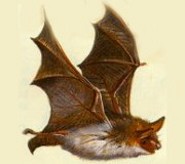 The Lesser mouse-eared bat (Myotis blythii) is one of the more common species of bat in Europe, the Middle East, and even the northwestern regions of India. The Lesser mouse-eared bat, along with its cousin the Greater mouse-eared bat (Myotis myotis), are two of the most numerous bat species in many parts of Europe and Asia and often roost together in larger colonies with other similar species. The Lesser mouse-eared bat is unique in the fact that it feeds almost exclusively in grasslands and meadows with tall vegetation, often hovering or even landing on the ground to capture insects off of the blades of grass.
The Lesser mouse-eared bat (Myotis blythii) is one of the more common species of bat in Europe, the Middle East, and even the northwestern regions of India. The Lesser mouse-eared bat, along with its cousin the Greater mouse-eared bat (Myotis myotis), are two of the most numerous bat species in many parts of Europe and Asia and often roost together in larger colonies with other similar species. The Lesser mouse-eared bat is unique in the fact that it feeds almost exclusively in grasslands and meadows with tall vegetation, often hovering or even landing on the ground to capture insects off of the blades of grass.Myotis blythii is abundant in many areas of southern Europe, while at the same time in areas such as Switzerland they are very rare and were designated as "Strongly Endangered" as recently as 1994. However, the species as a whole is abundant and widespread, with the only real threats being man-made; bat foraging areas are being overrun by urban and agricultural developments, and pollution is always a serious threat. Outside of the human threat, common predators of bats in Europe and Asia are primarily owls, snakes, and a variety of small mammals.
The Lesser mouse-eared bat is a nocturnal species that feeds at night by flying over fields and pastures scouting for insects like crickets and moths.
Lesser mouse-eared bats are small and have a very delicate appearance, with a soft brown fur often lighter on the underside and sometimes on the head. They typically roost in caves and buildings, church steeples and bell towers being among their favorites, but rarely cause any concern or inconvenience to the human population. The Myotis blythii averages around 16 grams, or 0.04 pounds, but some specimens have weighed in at over 20 grams or more. These bats typically grow to about 65 millimeters in length, or slightly larger than 2 ½ inches, with a wingspan of 350 to 400 millimeters which is equivalent to about one foot. These delicate mammals only have one pup per year, typically between May and July, and are crucial in their role as insect and pest population controllers, as well as helping to pollinate plants and remove pests from certain crops.
Picture of the lesser mouse-eared bat by GeForce3 at en.wikipedia, licensed under Creative Commons Attribution 3.0 Unported license.
The Lesser mouse-eared bat is listed as Least Concern (LR/lc), lowest risk. Does not qualify for a more at risk category. Widespread and abundant taxa are included in this category, on the IUCN Red List of Threatened Species
Namings for the lesser mouseeared bat
A young / baby of a lesser mouseeared bat is called a 'pup'. A lesser mouseeared bat group is called a 'colony or cloud'.Countries
Afghanistan, Albania, Austria, Bhutan, Bulgaria, China, France, Georgia, Germany, Greece, Hungary, Iran, Iraq, Israel, Italy, Jordan, Kazakhstan, Lebanon, Mongolia, Pakistan, Romania, Russia, Slovenia, Spain, Switzerland, Syria and TurkmenistanSome facts about the
Lesser mouse-eared bat
Adult weight : 0.023 kg (0.0506 lbs)
Maximum longevity : 33 years
Litter size : 1

Custom Search